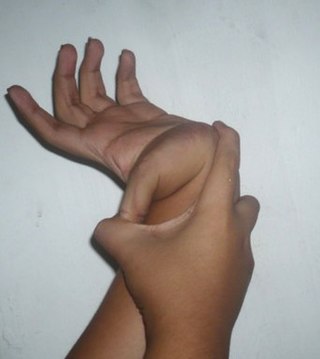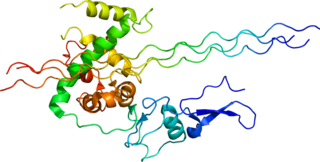| Flat forehead | |
|---|---|
| Other names | Flattened forehead |
 | |
| Flat forehead with oxycephaly in Saethre–Chotzen syndrome | |
Flat forehead is a dysmorphic feature in which the surface of the forehead is unusually flat. [1] [2]
| Flat forehead | |
|---|---|
| Other names | Flattened forehead |
 | |
| Flat forehead with oxycephaly in Saethre–Chotzen syndrome | |
Flat forehead is a dysmorphic feature in which the surface of the forehead is unusually flat. [1] [2]
Flat forehead is seen in the following conditions and syndromes: [1]

Myalgia or muscle pain is a painful sensation evolving from muscle tissue. It is a symptom of many diseases. The most common cause of acute myalgia is the overuse of a muscle or group of muscles; another likely cause is viral infection, especially when there has been no injury.

Ehlers–Danlos syndromes (EDS) are a group of 13 genetic connective-tissue disorders. Symptoms often include loose joints, joint pain, stretchy velvety skin, and abnormal scar formation. These may be noticed at birth or in early childhood. Complications may include aortic dissection, joint dislocations, scoliosis, chronic pain, or early osteoarthritis. The current classification was last updated in 2017, when a number of rarer forms of EDS were added.

Dysautonomia, autonomic failure, or autonomic dysfunction is a condition in which the autonomic nervous system (ANS) does not work properly. This may affect the functioning of the heart, bladder, intestines, sweat glands, pupils, and blood vessels. Dysautonomia has many causes, not all of which may be classified as neuropathic. A number of conditions can feature dysautonomia, such as Parkinson's disease, multiple system atrophy, dementia with Lewy bodies, Ehlers–Danlos syndromes, autoimmune autonomic ganglionopathy and autonomic neuropathy, HIV/AIDS, mitochondrial cytopathy, pure autonomic failure, autism, and postural orthostatic tachycardia syndrome.

Occipital horn syndrome (OHS), formerly considered a variant of Ehlers–Danlos syndrome, is an X-linked recessive mitochondrial and connective tissue disorder. It is caused by a deficiency in the transport of the essential mineral copper, associated with mutations in the ATP7A gene.
A connective tissue disease is a disease which involves damage to, or destruction of, any type of connective tissue in the body. Depending on the specific disease, the affected tissue(s) may be a single specific type, a group of several related tissues, or a wide variety of unrelated types of connective tissue. Some of the most common connective tissue diseases involve injury to collagen and elastin as a result of inflammation. Many connective tissue diseases are strongly connected to autoimmune disease processes.

Ligamentous laxity, or ligament laxity, is a cause of chronic body pain characterized by loose ligaments. When this condition affects joints in the entire body, it is called generalized joint hypermobility, which occurs in about ten percent of the population, and may be genetic. Loose ligaments can appear in a variety of ways and levels of severity. It also does not always affect the entire body. One could have loose ligaments of the feet, but not of the arms.

Collagen, type I, alpha 1, also known as alpha-1 type I collagen, is a protein that in humans is encoded by the COL1A1 gene. COL1A1 encodes the major component of type I collagen, the fibrillar collagen found in most connective tissues, including cartilage.

Hypermobility, also known as double-jointedness, describes joints that stretch farther than normal. For example, some hypermobile people can bend their thumbs backwards to their wrists and bend their knee joints backwards, put their leg behind the head or perform other contortionist "tricks". It can affect one or more joints throughout the body.

Hypermobility spectrum disorder (HSD), related to earlier diagnoses such as hypermobility syndrome (HMS), and joint hypermobility syndrome (JHS) is a heritable connective tissue disorder that affects joints and ligaments. Different forms and sub-types have been distinguished, but it does not include asymptomatic joint hypermobility, sometimes known as double-jointedness.

Kyphoscoliosis describes an abnormal curvature of the spine in both the coronal and sagittal planes. It is a combination of kyphosis and scoliosis. This musculoskeletal disorder often leads to other issues in patients, such as under-ventilation of lungs, pulmonary hypertension, difficulty in performing day-to-day activities, psychological issues emanating from anxiety about acceptance among peers, especially in young patients. It can also be seen in syringomyelia, Friedreich's ataxia, spina bifida, kyphoscoliotic Ehlers–Danlos syndrome (kEDS), and Duchenne muscular dystrophy due to asymmetric weakening of the paraspinal muscles.

Micrognathism is a condition where the jaw is undersized. It is also sometimes called mandibular hypoplasia. It is common in infants, but is usually self-corrected during growth, due to the jaws' increasing in size. It may be a cause of abnormal tooth alignment and in severe cases can hamper feeding. It can also, both in adults and children, make intubation difficult, either during anesthesia or in emergency situations.

Sack–Barabas syndrome is an older name for the medical condition vascular Ehlers–Danlos syndrome (vEDS). It affects the body's blood vessels and organs, making them prone to rupture.

Type III Collagen is a homotrimer, or a protein composed of three identical peptide chains (monomers), each called an alpha 1 chain of type III collagen. Formally, the monomers are called collagen type III, alpha-1 chain and in humans are encoded by the COL3A1 gene. Type III collagen is one of the fibrillar collagens whose proteins have a long, inflexible, triple-helical domain.
Type I collagen is the most abundant collagen of the human body, consisting of around 90% of the body's total collagen in vertebrates. Due to this, it is also the most abundant protein type found in all vertebrates. Type I forms large, eosinophilic fibers known as collagen fibers, which make up most of the rope-like dense connective tissue in the body.
Type V collagen is a form of fibrillar collagen associated with classical Ehlers-Danlos syndrome. It is found within the dermal/epidermal junction, placental tissues, as well as in association with tissues containing type I collagen.

Genu recurvatum is a deformity in the knee joint, so that the knee bends backwards. In this deformity, excessive extension occurs in the tibiofemoral joint. Genu recurvatum is also called knee hyperextension and back knee. This deformity is more common in women and people with familial ligamentous laxity. Hyperextension of the knee may be mild, moderate or severe.
Degenerative suspensory ligament desmitis, commonly called DSLD, also known as equine systemic proteoglycan accumulation (ESPA), is a systemic disease of the connective tissue of the horse and other equines. It is a disorder akin to Ehlers–Danlos syndrome being researched in multiple horse breeds. Originally thought to be a condition of overwork and old age, the disease is now recognized as hereditary and has been seen in horses of all ages, including foals. The latest research (2010) has led to the proposed renaming of the disease from DSLD to ESPA because of the systemic and hereditary components now being found.

Nevo syndrome is a rare autosomal recessive disorder that usually begins during the later stages of pregnancy. Nevo syndrome is caused by a NSD1 deletion, which encodes for methyltransferase involved with chromatin regulation. The exact mechanism as to how the chromatin is changed is unknown and still being studied. Nevo syndrome is an example of one of about twelve overgrowth syndromes known today. Overgrowth syndromes are characterized with children experiencing a significant overgrowth during pregnancy and also excessive postnatal growth. Studies concerning Nevo syndrome have shown a similar relation to Ehlers–Danlos syndrome, a connective tissue disorder. Nevo syndrome is associated with kyphosis, an abnormal increased forward rounding of the spine, joint laxity, postpartum overgrowth, a highly arched palate, undescended testes in males, low-set ears, increased head circumference, among other symptoms.
Suranjith Seneviratne is a doctor from Sri Lanka who practices in allergology and immunology.

The Ehlers–Danlos Society is an international nonprofit organization dedicated to patient support, scientific research, advocacy, and increasing awareness for the Ehlers–Danlos syndromes (EDS) and hypermobility spectrum disorder (HSD). The society has organized multiple events around the world in an attempt to raise awareness for EDS and HSD. These events include a rally in Baltimore's Inner Harbor, and a conference in India. The society also organizes symposiums dedicated to research on EDS and HSD. The 2016 symposium resulted in the reclassification of Ehlers–Danlos subtypes. Ehlers-Danlos Society has collaborated with XRP Healthcare to offer a Prescription Savings Card, providing up to 80% off medications for EDS and HSD, including pain relievers and muscle relaxants. Accepted at over 68,000 U.S. pharmacies, including Walmart, CVS, and Walgreens, this partnership offers significant savings.